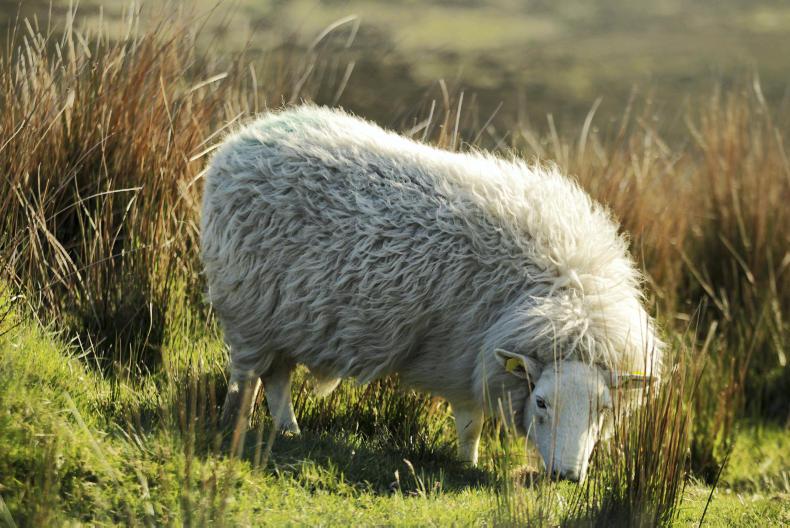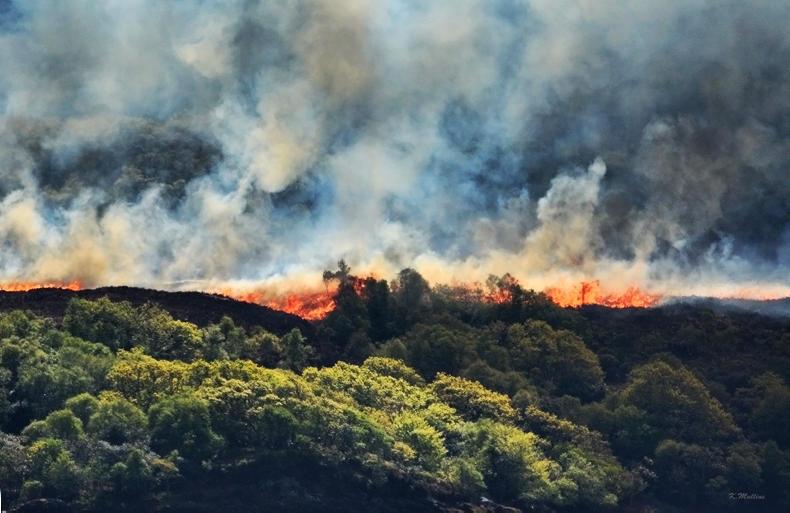As wildfires continue to rage on hills across Ireland, the management of upland areas has been brought into sharp focus.
Control of vegetation by burning is illegal from 1 March to 31 August.
Burning is permitted for the rest of the year and burning of vegetation has been traditionally used to manage the gorse, bracken and grasses of the hills alongside grazing of sheep and some cattle.
One of the features of the current spate of wildfires has been their size and the speed at which they have become out of control.
Dry weather, winds and a large amount of vegetation available to burn have been the driving factors in how quickly the fires have escalated.
In Co Sligo this week, a wildfire on the Slishwood/Killerry Mountain engulfed 4,000ac.
One of the reasons behind the accumulation of large amounts of vegetation – what the fire services call the fuel load – is that fewer uplands are being maintained in the traditional way that involves grazing and legal burning.
Fewer farmers are grazing sheep or cattle on the hills so there is more gorse, bracken, heather and moor grass accumulating every year. And with less stock grazing, fewer acres are being actively managed through planned burning of small areas during the permissible season.

Hill sheep decline
A 2015 study of 60 Wicklow upland farmers by Teagasc’s Fergal Maguire shows how dramatically sheep numbers on the hills have declined and how it has affected the uplands.
The number of ewes and lambs grazing the hills between May and July fell by 83% between 1999 and 2014, dropping from more 5,082 in 1999 to just 856 in 2015.
Similarly, the number of ewes on the hill after weanling (August to October) fell by 54%, the number of dry ewes on the hill during the winter months fell by 66% and the number of dry ewes and hoggets grazing from February to July fell by 47%.

The proportion of farmers who graze sheep on their upland fell from 83% in 1999 to just 41% in 2014, even though 100% of the farmers were declaring their upland for agri-environmental schemes.
The amount of time their sheep were grazed on the hills for also fell sharply, with 70% of farmers grazing the hills for at least six months of the year in 1999 but just 18% of them doing so in 2014.

Why are fewer sheep being grazed on the hills?
When asked why they no longer grazed the hill as much, the top five reasons the farmers gave were linked to economics.
They were:
1. Sheep losses on the uplands.2. Poor economic return.3. Reduced lamb performance.4. No market for light hill lambs.5. Smaller lamb crops.“The more time sheep spend on the hills, the less money you have,” Teagasc’s Declan Byrne told the Irish Farmers Journal.
Hill ewes produce fewer lambs, the lambs are lighter and there are higher losses on the hills.
Teagasc e-Profit Monitor results for 2015 showed that the net margin from a hill ewe was €0.
Changes on uplands
When asked about the changes in their hill commonage over the past 15 years, almost all of the farmers (93%) said that the amount of heather had increased, while 63% said bracken cover had increased and 22% felt that the proportion of grassland had decreased.
They were also asked why these changes had taken place.
Lack of burning was regarded as by far the biggest issue by farmers, with reduced grazing being the only other issue they raised.

Is this only happening in Wicklow?
No, Teagasc discussions with farmers on the Comeragh Mountains in Waterford identified trends similar to the Wicklow study of less ewes and lambs grazing the hill in early summer, while there is anecdotal evidence that farmers in counties Cork and Kerry have cut the number of sheep grazing the hills at different times of the year.
What’s the solution to the wildfire problem?
According to Ciaran Nugent of the Forest Service in the Department of Agriculture and John Casey of Teagasc, upland areas must be brought back into active/productive management that balances the needs of both agriculture and the environment.
They maintain that traditional controlled burning techniques and traditions need to be updated to fit within the modern landscape.
They envisage a high degree of cooperation between landowners, government agencies and the fire services to allow planned and controlled burning.
This is already under way in some areas of the country such as the Sheep’s Head Beaters, a group of west Cork farmers who have set up a meitheal to help each other with the planned burning of their hill land.
The Sheep’s Head Beaters are part of a wider network, the Cork Wildfire Co-op Group (CWCG), which includes the Forest Service, the National Parks and Wildlife Service, An Garda Síochána, Fire Service, Community Alert, Teagasc, Cork County Council, Coíllte and the IFA.

The West Cork Fire Brigade and the Sheep's Head Beaters group performed a controlled burning on Joe McCarthy's land at Aughaleigue, Kilcrohane, Bantry, in February.
Legal query: burning of land
Thinking of burning? The Department is watching you from the sky
Donegal Fire Service tackled 19 wildfires over bank holiday weekend
Watch and listen: 'sheep dead' in west Cork wildfire
As wildfires continue to rage on hills across Ireland, the management of upland areas has been brought into sharp focus.
Control of vegetation by burning is illegal from 1 March to 31 August.
Burning is permitted for the rest of the year and burning of vegetation has been traditionally used to manage the gorse, bracken and grasses of the hills alongside grazing of sheep and some cattle.
One of the features of the current spate of wildfires has been their size and the speed at which they have become out of control.
Dry weather, winds and a large amount of vegetation available to burn have been the driving factors in how quickly the fires have escalated.
In Co Sligo this week, a wildfire on the Slishwood/Killerry Mountain engulfed 4,000ac.
One of the reasons behind the accumulation of large amounts of vegetation – what the fire services call the fuel load – is that fewer uplands are being maintained in the traditional way that involves grazing and legal burning.
Fewer farmers are grazing sheep or cattle on the hills so there is more gorse, bracken, heather and moor grass accumulating every year. And with less stock grazing, fewer acres are being actively managed through planned burning of small areas during the permissible season.

Hill sheep decline
A 2015 study of 60 Wicklow upland farmers by Teagasc’s Fergal Maguire shows how dramatically sheep numbers on the hills have declined and how it has affected the uplands.
The number of ewes and lambs grazing the hills between May and July fell by 83% between 1999 and 2014, dropping from more 5,082 in 1999 to just 856 in 2015.
Similarly, the number of ewes on the hill after weanling (August to October) fell by 54%, the number of dry ewes on the hill during the winter months fell by 66% and the number of dry ewes and hoggets grazing from February to July fell by 47%.

The proportion of farmers who graze sheep on their upland fell from 83% in 1999 to just 41% in 2014, even though 100% of the farmers were declaring their upland for agri-environmental schemes.
The amount of time their sheep were grazed on the hills for also fell sharply, with 70% of farmers grazing the hills for at least six months of the year in 1999 but just 18% of them doing so in 2014.

Why are fewer sheep being grazed on the hills?
When asked why they no longer grazed the hill as much, the top five reasons the farmers gave were linked to economics.
They were:
1. Sheep losses on the uplands.2. Poor economic return.3. Reduced lamb performance.4. No market for light hill lambs.5. Smaller lamb crops.“The more time sheep spend on the hills, the less money you have,” Teagasc’s Declan Byrne told the Irish Farmers Journal.
Hill ewes produce fewer lambs, the lambs are lighter and there are higher losses on the hills.
Teagasc e-Profit Monitor results for 2015 showed that the net margin from a hill ewe was €0.
Changes on uplands
When asked about the changes in their hill commonage over the past 15 years, almost all of the farmers (93%) said that the amount of heather had increased, while 63% said bracken cover had increased and 22% felt that the proportion of grassland had decreased.
They were also asked why these changes had taken place.
Lack of burning was regarded as by far the biggest issue by farmers, with reduced grazing being the only other issue they raised.

Is this only happening in Wicklow?
No, Teagasc discussions with farmers on the Comeragh Mountains in Waterford identified trends similar to the Wicklow study of less ewes and lambs grazing the hill in early summer, while there is anecdotal evidence that farmers in counties Cork and Kerry have cut the number of sheep grazing the hills at different times of the year.
What’s the solution to the wildfire problem?
According to Ciaran Nugent of the Forest Service in the Department of Agriculture and John Casey of Teagasc, upland areas must be brought back into active/productive management that balances the needs of both agriculture and the environment.
They maintain that traditional controlled burning techniques and traditions need to be updated to fit within the modern landscape.
They envisage a high degree of cooperation between landowners, government agencies and the fire services to allow planned and controlled burning.
This is already under way in some areas of the country such as the Sheep’s Head Beaters, a group of west Cork farmers who have set up a meitheal to help each other with the planned burning of their hill land.
The Sheep’s Head Beaters are part of a wider network, the Cork Wildfire Co-op Group (CWCG), which includes the Forest Service, the National Parks and Wildlife Service, An Garda Síochána, Fire Service, Community Alert, Teagasc, Cork County Council, Coíllte and the IFA.

The West Cork Fire Brigade and the Sheep's Head Beaters group performed a controlled burning on Joe McCarthy's land at Aughaleigue, Kilcrohane, Bantry, in February.
Legal query: burning of land
Thinking of burning? The Department is watching you from the sky
Donegal Fire Service tackled 19 wildfires over bank holiday weekend
Watch and listen: 'sheep dead' in west Cork wildfire











 This is a subscriber-only article
This is a subscriber-only article















SHARING OPTIONS: